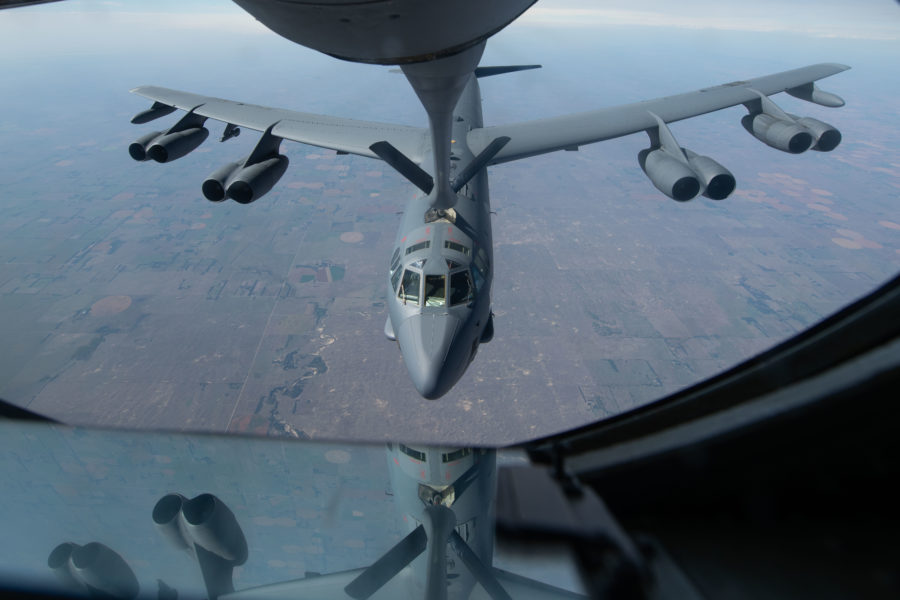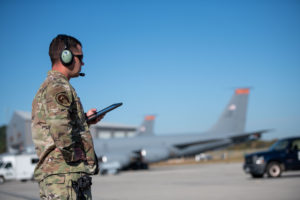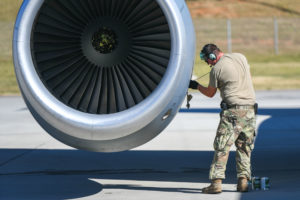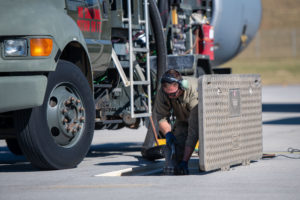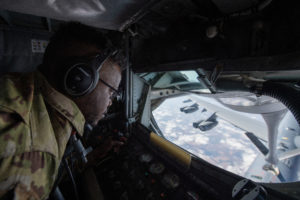A pair of KC-135s from Fairchild Air Force Base, Wash., continuously operated for 72 hours, landing only to swap crews, refuel, and service engine oil while keeping at least one engine running at all times.
The mission, which took place from Oct. 4 to 7 and covered more than 36,000 miles—roughly one and a half times around the Earth. It set a new endurance record for the aircraft, far surpassing the previous mark of 40 hours, according to a press release from the 92nd Air Refueling Wing.
The KC-135s and crews that conducted the mission are part of the 92nd ARW, but they received help from Airmen in the 141st Air Refueling Wing, also at Fairchild; the 452nd Air Mobility Wing at March Air Reserve Base, Calif.; and the 134th Air Refueling Wing at McGhee Tyson Air National Guard Base, Tenn.
Over the course of those 72 hours, the tankers refueled B-2 and B-52 bombers, as well an E-3 Sentry and an E-6B Mercury. When they landed, crews conducted hot-pit refueling, and aircrews swapped out while maintenance Airmen conducted engine oil servicing.
By continuously operating for so long, the Airmen were able to practice techniques related to agile combat employment, the operational concept in which small teams move quickly and operate out of remote or austere locations.
“This was the first continuously operating 72-hour endurance mission for the KC-135,” Col. Chad Cisewski, 92nd Operations Group commander, said in a statement. “Part of the ACE concept is that aircraft will continue forward while spending minimal time on the ground. This mission is one example of Airmen utilizing ACE concepts the way they could be employed in the Pacific. I’m extremely proud of both our operations and maintenance team for their tireless work on this.”
Air Mobility Command, which oversees the tanker fleet, has increasingly emphasized both ACE and operations in the Indo-Pacific in its training missions. In May, a KC-46 from the 22nd Air Refueling Wing flew for more than 24 hours straight, setting an AMC record.
At AFA’s Air, Space & Cyber conference in September, AMC commander Gen. Mike Minihan laid out his “Mobility Manifesto,” pledging to push those efforts even further. His stated goals include studying the idea of reduced “skeleton” crews for the KC-46 and other aircraft and having the KC-46 fly 30-hour and 36-hour sorties.
Such long flights and missions, covering massive distances, may be needed in the Indo-Pacific region, a vast area known for its “tyranny of distance.” The Air Force and the broader Pentagon have increasingly emphasized the U.S. Indo-Pacific Command area of responsibility as part of a pivot toward competition with China, and Minihan has said AMC’s Mobility Guardian 23 exercise will take place over the Pacific.
Col. Chesley Dycus, 92nd ARW commander, made reference to that upcoming exercise in detailing the benefits of the KC-135 endurance mission.
“This took tenacity and exceptional teamwork to accomplish,” Dycus said in a statement. “The lessons learned here, and our readiness will only improve the wing’s ability to support AMC’s ‘crown jewel of mobility exercises’ Mobility Guardian in 2023 and demonstrate our critical capabilities in the Pacific.”
